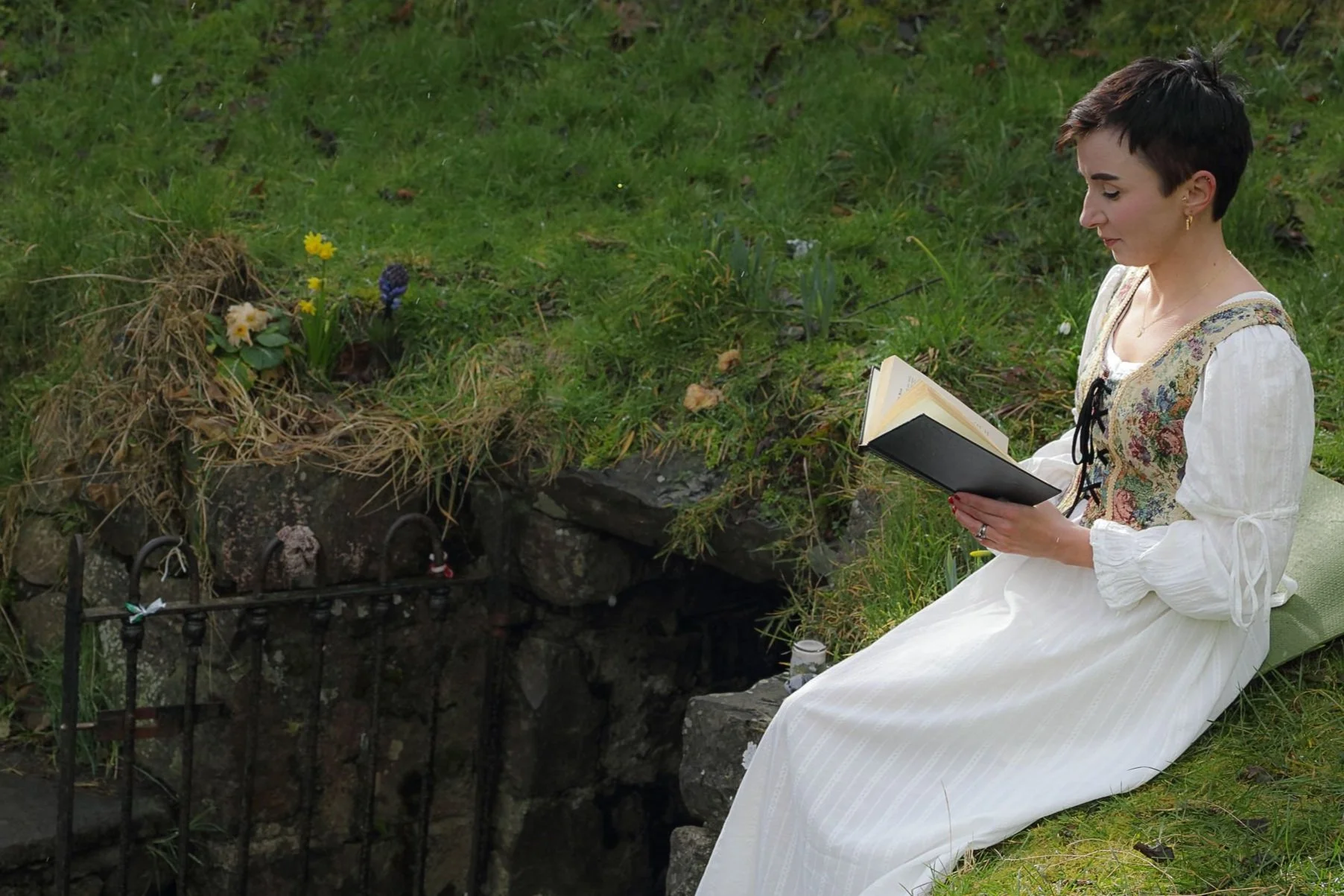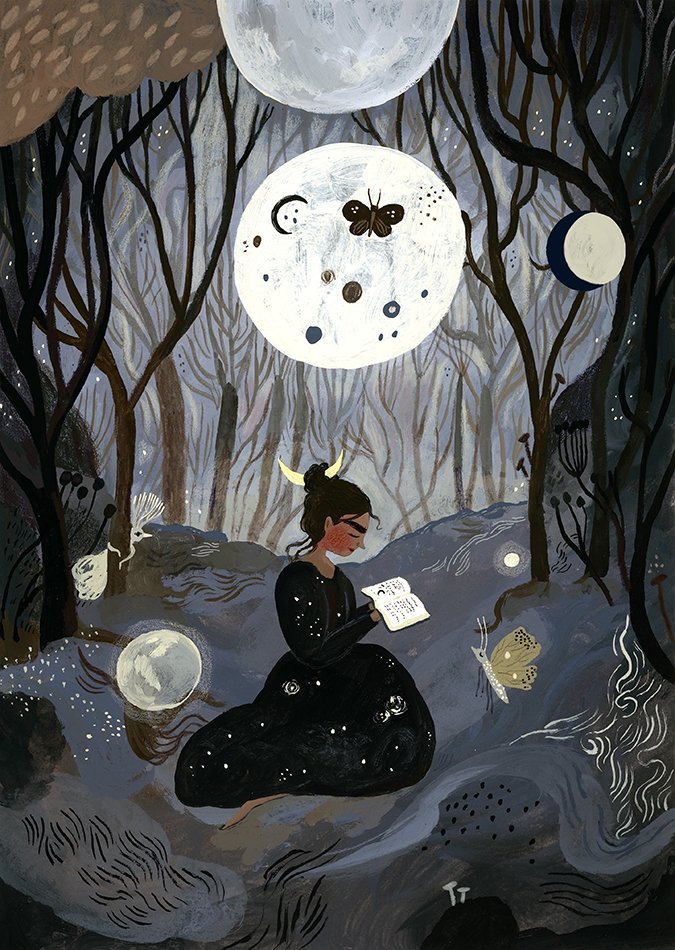
MUSINGS FROM THE OTHERWORLD
My current writings and musings on Celtic feminine mysticism and soulful living now find their home on Substack. I invite you to join me there but I’ve also preserved an archive of my previous writings (2021-2023) below.
A Letter Writing Ritual
These letters were given to me after my Gran passed 15 years ago, they were found among others that I wrote in a treasured box she kept. She is now a well and wise ancestor who I feel as deeply connected to as when she was alive. And so this winter, I am continuing to write to her sharing about my inner and outer landscapes.
Art by Johannes Rosierse
“You have a touch in letter writing that is beyond me. Something unexpected, like coming round a corner in a rose garden and finding it still daylight.”
Virginia Woolf
Recently, I found a letter posted on 21st June 1999, the summer solstice in the last year of that decade, that I sent to my grandmother, Frances O’Sullivan, my gorgeous “Gran”. I was a teenager at the time away without my family studying Gaeilge/Irish in the Gaeltacht in Co. Donegal. This was my third summer to go away to study Irish and so I was used to the experience by this stage.
As my eyes fall upon my own writing, it’s curious to read now 24 years later what was happening in my inner landscape… how I was feeling, the small little revelations I was having about the language, an experience of a “blind date” that made me laugh so much I was nearly sick, something I have no recollection of now (it must have been a school sketch or show we put on)!
I also shared about my outer landscape, about the Bean an Tí, the “Woman of the House” and her small children who were the age that my own children are now. How they were bilingual and adorable. The Céilí’s, the dances each night and the craic of losing the run of ourselves, swinging one other so hard that we’d take flight during The Siege of Ennis (one of the dances).
These letters were given to me after my Gran passed 15 years ago, they were found among others that I wrote in a treasured box she kept. She is now a well and wise ancestor who I feel as deeply connected to as when she was alive. And so this winter, I am continuing to write to her sharing about my inner and outer landscapes.
Letter Writing Ritual
This is an invitation to write a letter to a well and wise ancestor or a mythic ancestor this Samhain. For example, you might like to write to the Cailleach, the Gaelic Goddess, our Seanmháthair Naofa, our Sacred Grandmother, who is deeply associated with these winter months in Ireland/Éire, the Isle of Man/Ellan Vannin and Scotland/Alba. Or whoever calls to you at this time, listen and you’ll hear them whisper.
The Tradition by Julia Jeffrey
Open up your ritual space before you write, light a candle to honour the flame of your lineage, both clan and mythic ancestors.
Remember, when you handwrite, you are literally shaping your words with your body. Your handwriting is utterly unique to you, and so as you write in ways you create and recreate yourself.
Share with your ancestor about what’s happening in your inner landscape, your world of thoughts, emotions, feelings, sensations and intuitions.
Then share about your outer landscape, what is happening beyond your window in the world? How does the outer world relate back to your inner world?
Write with free abandon in full honesty so as not to lie to yourself or to your ancestor.
What guidance would you welcome in a return letter from your ancestor? This may come to you in the form of a dream, a synchronicity, an intuitive spark - a mirroring back to you.
If ever there’s been a time to remember our global interconnectedness, it is now. Let the Goddess be your guide.
The Otherworld by Tijana
Once you have written your letter, you can place it in an envelope, even address it if you like, allow the spell of your imagination to work its wonder.
Then place your letter on your altar, or a sacred space, or you can write a series of letters and continually wrap them in string. You will know what to do. They are your keepsakes.
In time, reopen your letter and journal in response to the guidance that did come to pass. Perhaps at the Winter Solstice or Imbolc or whatever season you find yourself in.
“She is ideas, feelings, urges, and memory. She has been lost and half-forgotten for a long, long time. She is the source, the light, the night, the dark and daybreak… She is the one we leave home to look for. She is the one we come home to.”
Clarissa Pinkola Estés
Voices of Celtic Wisdom
I am thrilled that I will be joining the teaching team of Voices of Celtic Wisdom. This is a 4-month programme exploring living threads of the earth-based cultures of Ireland, Scotland, England and Wales with song, story, lore and hands-on crafting workshops.
Other teachers include Dolores Whelan, Manda Scott, Angharad Wynne, Tara Brading, Mary McLaughlin, Danu Forest, Dougie MacKay, Seoras Macpherson… and more wondrous souls.
The programme runs from 30th November 2023 to 25th March 2024.
Becoming An Ancestor
My boyfriend and I walked hand-in-hand, but we weren’t alone. All throughout the funeral, I’d felt a presence sitting next to me on the pews, watchful and wide-eyed. As we walked towards the graveyard, I felt her soft, warm hand in mine.
By Amelia Furlong
Samhain as an event has come and gone, but the effects of this year’s Celtic new year are still lingering in my mind.
Samhain is often viewed as a time for releasing what desires to die. I interpret this as a time when I release the old me; a rebirth from ambitions and patterns that no longer serve me to new, purpose-driven ones.
In fact, I even decided to move to Ireland after a DIY Samhain ritual that I performed in Orange County, California, in 2018. I was searching, then, for who I was meant to be, ready for the old me to die. I hoped that by coming to the land of my ancestors, I would find answers. After two years in Ireland, all of those questions have been satisfactorily answered, and this Samhain I found my thoughts drifting, instead, to my own role as an ancestor.
Releasing what desires to die
I work as a content writer for a wedding corporation and am in a long-term, happy relationship. So inevitably, questions have been swirling recently about marriage and children. This is compounded by the fact that I’m turning 30 next month and many of my friends are getting married and starting families. But I’m a wanderlusting Sagittarius with Venus in Scorpio. I don’t know if I’m ready to release the wild, untameable side of myself and “settle down”. And yet, it pulls on me.
Considering all this, I was determined to use Samhain 2021 as a chance to ask what direction my life should be going. I had plans to attend a bonfire lighting at Tlachtga, now known as the Hill of Ward. Tlachtga was a druidess who travelled with her father, the infamous druid Mug Ruith, to Italy, to study with the sorcerer Simon Magus. There, however, she was raped by his three sons. She escaped back to Ireland and gave birth to triplets before dying of grief. The hill is named after her and is one way in which her tragedy is etched into the landscape. On Samhain, all the fires in Ireland would be extinguished, and druids would gather on Tlachtga to light one great bonfire.
Art by Robin Eisenberg
31 October, however, didn’t go as planned, and I only got as far as Athenry, where I contracted food poisoning at a McDonald’s. My disappointment was palpable; I had been eager to celebrate a real Samhain in Ireland, as the previous two had been stymied by graduate school and the pandemic. It was my first Samhain, after all, that had spurred me to move to Ireland.
The first Samhain
This occurred in 2018, when I was working on a political campaign in Irvine, California. The reproductive rights nonprofit where I worked had sent me to Southern California for two weeks to help unseat an anti-choice Republican and elect a pro-choice Democrat. This wasn’t the first campaign I’d worked on, but it was to be my last.
At this point, I knew that I could not go on much longer as an activist. The confirmation hearings of Brett Kavanaugh the month before had completely broken me. The hopelessness with which my work had infected me had led to an all-consuming rage. I was extremely unhappy and desperately wanted to quit my job to become a writer.
But this felt impossible. Not only did I have no idea how to make money from writing, but I didn’t feel confident in myself as an artist. I’d visited Ireland the summer before, and while there I had become obsessed with moving to Galway to write a novel, but this seemed like a pipe dream.
While in Ireland I had also learned about Samhain, and the magic of it captivated me at once. I was drawn to the idea of a time when the veil between the worlds grows thin, when one can commune with spirits. I didn’t quite know if I believed in spirits, but I knew I wanted to.
So while in Orange County, I decided to try my hand at celebrating Samhain. I wanted to ask my ancient Irish ancestors if I should quit my job, move to Ireland, and do a graduate program in writing. I wanted them to give me strength to make the leap. On Halloween I drove down to Laguna Beach, bought a black pillar candle at a roadside mysticism shop, and, near midnight, hiked down to the beach. It was deserted. All alone under a bright moon, I drew a circle in the sand. Then I sat inside of it and lit my candle. Feeling foolish, I cleared my throat and spoke aloud to the night. I asked my ancestors - if they were there - for permission to leave my “important” work in reproductive rights, to leave behind my anger and sadness, in order to pursue my real passion in the land where they were born and died.
I’m still not sure if anyone answered me. I felt something, but it might just have been the breeze off the Pacific. Whatever it was, I suddenly knew what I had to do. The activist was ready to be released. The writer was ready to be born.
Old Answers and New Questions
On September 4, 2019, I flew to Ireland to begin an MA in Writing at the National University of Ireland-Galway. In the next two years I would fall in love, write two and a half novels, start writing full-time, and let my anger and hopelessness die.
But of course, my wanderlust has its drawbacks. I feel isolated from my family, who all live in America, and cut off from my community. I’ve never lived in a place long enough to put down roots. Even now, my boyfriend and I are making plans to move to London or Berlin, where we’ll live for a year or two before moving onto the next place.
So as my thirties approach, it’s hard not to turn my attention to the big decisions that I will have to make this decade.
Will I return to America to care for my aging parents, or stay over here and continue my European adventure? Will I get married? Will we settle down and raise a family? Or will I galavant across the globe, perpetually single and wild, writing novels that become like children?
After my failure to reach the Hill of Ward, I assumed I’d have to wait another year to get to ask my ancestors these questions. But tragedy has its own agenda.
The Funeral
Shortly after Samhain, my friend A.’s mother passed away. She’d been sick for a while, and while the news wasn’t shocking, it was devastating. My boyfriend and I journeyed to Trim on Monday, 8 November for the funeral. The date of this funeral was disquieting. While Samhain is traditionally celebrated on 31 October and 1 November, the actual calendar date in 2021, based on astronomical calculations, is 7 November. Attending a funeral just two days later, when the veil between the worlds would still be sheer, felt eerie.
The funeral was very sad and very moving. A.’s mother was an astonishing woman. Although I never met her, her warmth and wisdom were evident in the stories her large, adoring family told about her. She was a gardener, a nurturer of life. She had deep roots in the community. My friend - a storyteller, a lover of Irish myth, and one of the most thoughtful people I know - is a testament to her legacy. Her spirit lives on in him, and he will tell her story for the rest of his life. The importance of ancestors - not the long-dead, ancient ones, but our most immediate - had never been more clear to me.
After the funeral, we walked in a procession through the streets of Trim. Cars pulled over to let us by. Not one seemed annoyed or angry by the inconvenience. Instead, they sat in reverent silence, witnessing her passing.
I’d never been to an Irish funeral before. I’d never walked through the streets with a coffin and watched as the entire community came to a standstill to pay their respects to the deceased. It was a profound example of how meaningful a life is that is lived in one place, spent raising children, passing down knowledge, and caring for the community.
My boyfriend and I walked hand-in-hand, but we weren’t alone. All throughout the funeral, I’d felt a presence sitting next to me on the pews, watchful and wide-eyed. As we walked towards the graveyard, I felt her soft, warm hand in mine. I sensed that she had questions about death, but I also knew she wasn’t afraid. She was brave, just like me. She was gentle, just like my boyfriend.
She doesn’t exist yet, but we have a name for her. We don’t know if we’ll ever meet her, but we hope we will.
Becoming an ancestor
Art by Robin Eisenberg
Was this spirit a figment of my imagination, conjured up to help me process the death of A.’s mother, which, inevitably, forced me to think about my own parents’ mortality? Was she a way of reassuring myself that life goes on, that the next generation will continue to tell our stories? Or was the veil between our worlds flickering, allowing her to escape into mine in the hour of my need?
I think I know. The part of me that followed the whispers on the wind to this side of the world knows.
It’s okay if I’m not ready to settle down. The wanderlusting, wild woman in me is not quite ready to die and be reborn as an ancestor; a wife; a mother. The spirit I met knows this, and she doesn’t want to rush me. But when I’m ready, she’ll be waiting.
What about you?
As you process your Samhain experience, here are some questions you can ask yourself:
What were the Samhain rituals that resonated with you this year? What would you like to incorporate into your celebration next year?
Is there a part of you that is ready to be released, old ambitions and patterns that no longer serve you? What new, purpose-driven paths are you ready to embrace?
What parts of yourself are not ready to be released? Are there certain ambitions you need to see through to the end before you can turn to new paths?
ABOUT THE AUTHOR
Amelia Furlong is a content writer, ghostwriter, and novelist living in Galway, Ireland. She graduated from the MA in Writing at the National University of Ireland, Galway in 2019 and has published articles and poetry in Ireland and abroad. She is currently working on a pirate romance novel and an anti-romantic comedy screenplay.









